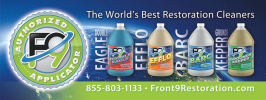

Craig Harrison
The Fix: We ( Front 9 Restoration ) have developed tricks, technique to fix and smooth out most concrete etch marks.
If etching happens to you, please give us a call at 855-803-1133.
It's a common misconception in our industry that new concrete can't be surface cleaned.
The truth is, every slab of concrete is different, has different psi tensile strengths and has varying degrees of laitance. Laitance is the proper term for the "cream" layer of the concrete. It is the topical film that forms through varying finishing techniques. Sometimes it is harder and dense, sometimes it is weak and flaky. The type and depth of laitance is different on every slab. The age of the concrete has a little bit of effect on the hardness of the laitance but not as much as you'd think. Brand new concrete (within one month of the pour) shouldn’t power washed or rinsed, but after that it can. You should use more caution with newer concrete because it can etch more quickly than older concrete but it still can absolutely be power washed. The issue most pressure washing companies face is how to get the surface of the concrete clean without pulling off the cream layer or laitance with the surface cleaner. All you have to do is match the psi of your surface cleaner to just below what the "cream layer" can handle. You can change your tips, angle your tips further away from the concrete (if your surface cleaner allows for this), adjust your spray bar height (if your surface cleaner does this), OR you can get a surface cleaner pressure regulator.
One of these Surface Cleaner
Pressure Regular kits is now being sold from Russ Johnson at Southside Equipment, appropriately called “Craig’s Pressure Regulator”. Marco Ramonda with Washmart now has one as well as Power Wash Store and Sirocco. In my opinion, ALL surface cleaners should be sold with a pressure adjustment kit option. Yes, you can always just use a ball valve and close it up a little, but using a pressure regulator is much more smooth, easier to use and directs the bleed water back to the surface cleaner where it can be used to make the cleaning go faster.
More On Etching:
The real issue is that the top layer of concrete is always the softest part of the slab. Some is harder and more durable than others. The manufacturers of surface cleaners should make them pressure adjustable at the gun and disclose that the pressure may etch some concrete. Then, it is up to the user to adjust the pressure of the surface cleaner to match the concrete. You want to get the pressure to where the concrete can handle it, but without etching. Every slab is different. Yes, newer concrete etches easier but it doesn't have to etch. But with that being said, ALL concrete can etch. Every employee should be properly trained to know what etching is, how it happens, what it looks like wet vs. dry, how to fix it and how not to make it happen in the first place. Even then, sometimes you can very lightly etch concrete and not even know until it's dry.
